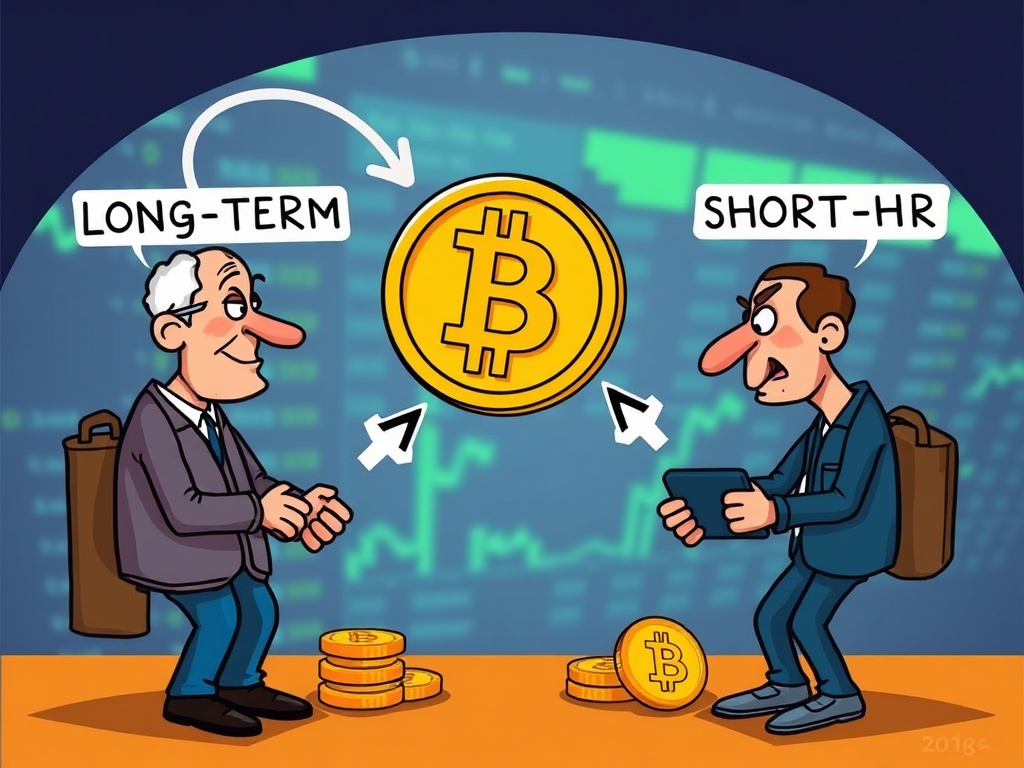BitcoinWorld

Bitcoin Supply Rotation: Unpacking the Dramatic 223K BTC Holder Shift
Are you tracking the pulse of the crypto market? Then you’ve likely heard whispers of significant movements beneath the surface. A truly intriguing development has caught the attention of market analysts: a massive Bitcoin supply rotation. Over the past 30 days, an astounding 223,602 BTC, equivalent to billions of dollars, has transitioned from the wallets of long-term holders (LTHs) to those of short-term holders (STHs). This isn’t just a statistical blip; it’s a profound shift that could signal evolving market dynamics and potential future price action. This report, highlighted by CryptoQuant contributor Maartunn on X, underscores a growing momentum in how Bitcoin’s available supply is being redistributed, making it a crucial indicator for anyone invested in the digital asset space.
What Exactly is Bitcoin Supply Rotation and Why Does It Matter?
Before diving deeper into the implications of this particular shift, let’s clarify what Bitcoin supply rotation truly means. In the world of cryptocurrency, holders are often categorized based on how long they’ve held their assets. Long-term holders (LTHs) are typically those who have held their Bitcoin for more than 155 days. These individuals or entities are often seen as ‘strong hands’ – investors with conviction, less likely to sell during price fluctuations, and who generally accumulate Bitcoin for its long-term value proposition. They are the bedrock of Bitcoin’s scarcity model.
- Long-Term Holders (LTHs): These are the patient investors. They often buy Bitcoin and hold it through market cycles, seeing it as a store of value or a long-term investment. Their selling activity can indicate significant shifts in market sentiment or profit-taking after substantial rallies.
- Short-Term Holders (STHs): Conversely, short-term holders are those who have acquired their Bitcoin within the last 155 days. This group often includes traders, speculators, or new market entrants who might be more reactive to price movements, seeking quicker gains, or simply experimenting with crypto. Their buying and selling patterns tend to contribute more to short-term volatility.
When Bitcoin moves from an LTH to an STH, it signifies that an asset previously held with a long-term perspective has now entered the realm of potential short-term trading or distribution. This shift matters immensely because it changes the ‘liquidity profile’ of the circulating supply. Bitcoin held by LTHs is often considered ‘illiquid’ or ‘dormant’ supply, while Bitcoin held by STHs is more ‘liquid’ and readily available for sale on exchanges. A significant Bitcoin supply rotation from LTHs to STHs suggests that a substantial amount of previously dormant supply is now active and could potentially exert selling pressure if STHs decide to realize profits or cut losses.
Decoding the 223K BTC Bitcoin Supply Rotation Data
The specific figure reported by Maartunn – 223,602 BTC – is not just a large number; it represents a considerable portion of Bitcoin’s circulating supply. To put this into perspective, this amount is roughly 1.14% of Bitcoin’s current circulating supply of approximately 19.7 million BTC. This movement occurred within a mere 30-day window, highlighting the rapid pace of this transition. Such a rapid and large-scale shift is precisely why it warrants close examination.
On-chain analytics platforms like CryptoQuant provide invaluable insights into these movements by tracking Bitcoin’s journey across different wallet types and timeframes. Maartunn’s report leverages these sophisticated tools to identify when coins that haven’t moved for extended periods suddenly become active again, indicating a change in holder type. This isn’t about identifying specific individuals, but rather understanding the aggregate behavior of large groups of market participants.
Consider the implications:
- Increased Market Liquidity: More Bitcoin is now in the hands of those who are more likely to trade it, potentially increasing liquidity on exchanges.
- Potential for Volatility: STHs are typically more sensitive to price swings. Their reactions can amplify market movements, both upwards and downwards.
- Profit Realization: Many LTHs accumulated Bitcoin at much lower prices. This shift could indicate significant profit-taking after Bitcoin’s impressive rally, including its recent ascent towards new all-time highs.
This data serves as a critical pulse check on the market’s underlying health and sentiment. It tells us that a significant portion of the ‘old’ supply is now in ‘new’ hands, and those new hands might have different intentions than the original long-term holders.
What Triggers a Major Bitcoin Supply Rotation Among Holders?
Understanding the ‘why’ behind this substantial Bitcoin supply rotation is key to anticipating its effects. Several factors could be motivating long-term holders to finally part with their cherished coins:
- Profit-Taking After Price Surges: Bitcoin has seen remarkable price appreciation in recent months, even hitting new all-time highs. Many LTHs acquired their BTC at significantly lower prices, sometimes even below $10,000 or $20,000. Reaching new peaks provides an opportune moment for these holders to realize substantial profits, de-risking their portfolios or funding other ventures. This is a natural cycle in bull markets.
- Anticipation of a Market Correction: Some LTHs might be taking profits out of a belief that the market is overheated and due for a correction. They might be front-running a potential downturn, planning to buy back at lower prices. This strategic move is common among seasoned investors.
- Macroeconomic Factors: Broader economic conditions, such as inflation concerns, interest rate policies, or geopolitical events, can influence investment decisions across all asset classes, including Bitcoin. LTHs might be re-evaluating their asset allocation in response to these macro shifts.
- Influence of Spot Bitcoin ETFs: The approval and subsequent success of spot Bitcoin Exchange-Traded Funds (ETFs) in the US have introduced a new avenue for institutional and retail investors to gain exposure to Bitcoin. While ETFs have brought new demand, they might also be indirectly influencing LTH behavior. Some LTHs might be moving their holdings to benefit from the liquidity and regulatory clarity offered by ETFs, or perhaps converting their direct holdings into ETF shares for ease of management.
- Market Sentiment Shifts: A subtle but powerful factor is the overall market sentiment. If the prevailing sentiment shifts from extreme greed to caution, even LTHs might feel compelled to secure gains.
It’s rarely a single factor but often a confluence of these elements that drives such a significant shift. The sheer volume of 223,602 BTC suggests a coordinated or at least widely shared rationale among a large segment of the long-term holding community.
How Does This Bitcoin Supply Rotation Impact Market Dynamics?
The transition of such a large quantity of Bitcoin into the hands of short-term holders has several potential implications for the market’s immediate and medium-term future. This isn’t just a theoretical exercise; it has tangible effects on how Bitcoin’s price might behave.
- Increased Volatility: STHs are inherently more sensitive to price movements. They are more likely to buy on dips and sell on rallies, or panic sell during sharp corrections. This increased reactivity can lead to amplified price swings, making the market more volatile in the short term.
- Potential for Selling Pressure: With more Bitcoin in ‘weaker hands’ (meaning, less conviction to hold through significant drawdowns), there’s a higher potential for increased selling pressure. If the market experiences a downturn, STHs might be quicker to liquidate their positions, potentially accelerating a price decline.
- Shift in Market Structure: This shift can alter the market’s underlying structure. When LTHs dominate, the market often exhibits greater stability due to their ‘hodling’ behavior. As STHs gain more control over the circulating supply, the market might become more susceptible to speculative movements and liquidity shocks.
- Opportunity for New Entrants: On the flip side, this supply rotation also represents an opportunity. As LTHs sell, new buyers, including new retail investors or institutions entering via ETFs, are absorbing this supply. This indicates a healthy demand side, preventing a complete collapse in prices. It’s a natural process of supply meeting demand, where old money takes profits and new money enters the ecosystem.
- Re-evaluation of Market Cycle Stage: Analysts often use LTH/STH behavior as a proxy for market cycle stages. A significant LTH distribution event like this can suggest that the market is transitioning from an accumulation phase into a distribution or profit-taking phase, which often precedes a cooling-off period or correction.
It’s important to remember that these are potential outcomes. The actual impact will depend on a multitude of factors, including overall market sentiment, macroeconomic conditions, and the continued influx of new demand.
Navigating the Shifting Tides: Your Strategy Amidst Bitcoin Supply Rotation
Given this significant Bitcoin supply rotation, how should you, as an investor or enthusiast, approach the market? Understanding these dynamics isn’t just academic; it’s crucial for informed decision-making.
- Monitor On-Chain Metrics Closely: Continue to follow reports from on-chain analysts like Maartunn and platforms such as CryptoQuant or Glassnode. These tools offer real-time insights into supply dynamics, exchange flows, and holder behavior, providing an edge in understanding market trends. Key metrics to watch include Exchange Netflow, Miner Reserves, and Dormancy Flow.
- Practice Risk Management: With potentially increased volatility, solid risk management becomes paramount. This includes setting clear stop-loss levels, diversifying your portfolio (if appropriate), and not over-leveraging.
- Re-evaluate Your Investment Horizon: If you are a long-term investor, this shift might present opportunities to accumulate more Bitcoin during potential dips. If you are a short-term trader, be prepared for sharper price movements and adjust your strategies accordingly.
- Dollar-Cost Averaging (DCA): For many, dollar-cost averaging remains a prudent strategy. Consistently investing a fixed amount over time, regardless of market fluctuations, can help mitigate the risks associated with volatility and allows you to average into positions.
- Stay Informed, Not Emotional: The crypto market is prone to emotional reactions. Base your decisions on data and analysis, not fear of missing out (FOMO) or fear, uncertainty, and doubt (FUD). This Bitcoin supply rotation is a natural market phenomenon, not necessarily a harbinger of doom.
While the transfer of 223,602 BTC is substantial, it’s also a sign of a maturing market where participants are actively managing their positions based on evolving conditions. Your ability to adapt and understand these underlying shifts will be key to navigating the road ahead.
Challenges and Considerations
While on-chain data offers incredible transparency, interpreting it comes with its own set of challenges. It’s vital to remember that correlation does not always imply causation. A Bitcoin supply rotation from LTHs to STHs is a strong signal, but it doesn’t guarantee a specific outcome. Other factors, such as macro-economic surprises, regulatory changes, or unforeseen black swan events, can always influence the market in unpredictable ways. Furthermore, the motivations behind LTH selling can be diverse, from profit-taking to rebalancing portfolios for tax purposes, making a singular interpretation difficult. It’s always best to consider these on-chain metrics as part of a broader analytical framework.
The dramatic 223,602 BTC shift from long-term to short-term holders, as reported by CryptoQuant’s Maartunn, is a compelling narrative in the ongoing Bitcoin story. It signals a significant redistribution of supply, moving from patient, conviction-driven hands to more active, potentially speculative ones. This Bitcoin supply rotation is a natural part of market cycles, particularly after periods of strong price appreciation. While it introduces the potential for increased volatility and short-term selling pressure, it also highlights the market’s ability to absorb substantial supply and welcome new participants. For investors, understanding this underlying dynamic is crucial. It underscores the importance of on-chain analysis, prudent risk management, and a clear investment strategy. As Bitcoin continues its journey, these shifts in holder behavior will remain key indicators for charting its future course.
Frequently Asked Questions (FAQs)
Q1: What is the main significance of 223K BTC moving from long-term to short-term holders?
This movement signifies that a large amount of previously dormant Bitcoin is now in the hands of more active traders and speculators. It suggests potential profit-taking by long-term holders and could lead to increased market liquidity and short-term volatility, as these new holders are more likely to buy and sell based on recent price action.
Q2: How do analysts identify a ‘long-term holder’ versus a ‘short-term holder’?
Analysts typically define long-term holders (LTHs) as entities that have held their Bitcoin for more than 155 days, based on on-chain data. Short-term holders (STHs) are those who have acquired their Bitcoin within the last 155 days. This distinction helps categorize market participants by their typical holding duration and investment intent.
Q3: Does this Bitcoin supply rotation necessarily mean a price drop is coming?
Not necessarily. While a significant shift to short-term holders can increase the potential for selling pressure and volatility, it doesn’t guarantee a price drop. It could also indicate healthy demand absorbing the supply from long-term holders. The actual outcome depends on overall market sentiment, new demand, and macroeconomic factors.
Q4: What actionable steps can an investor take in response to this supply shift?
Investors should consider monitoring on-chain metrics, practicing robust risk management (e.g., setting stop-losses), re-evaluating their investment horizon, and potentially employing strategies like dollar-cost averaging. Staying informed and making decisions based on data rather than emotion is crucial during such shifts.
Q5: Is this Bitcoin supply rotation a common occurrence in crypto markets?
Yes, significant Bitcoin supply rotation events are a natural part of market cycles, especially after periods of substantial price appreciation. Long-term holders often take profits at market peaks, and this supply is then absorbed by new entrants or short-term traders, contributing to the dynamic nature of the crypto market.
If you found this analysis insightful, consider sharing it with your network! Understanding these crucial market dynamics helps everyone make more informed decisions in the fascinating world of cryptocurrency. Spread the knowledge and let’s navigate the future of digital assets together.
To learn more about the latest crypto market trends, explore our article on key developments shaping Bitcoin price action.
This post Bitcoin Supply Rotation: Unpacking the Dramatic 223K BTC Holder Shift first appeared on BitcoinWorld and is written by Editorial Team





